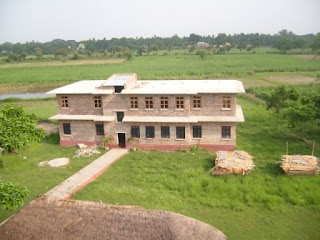
When I first started reading books about Krishna Consciousness and Bhakti yoga the holistic philosophy and lifestyle seemed to fill the gap between the theoretical and the practical. The Bhagavad Gita instructs one on how to spiritualize one's seemingly secular or mundane activities.
Prior to reading the Bhagavad Gita I had read some "spiritual" books that promoted perpetual abandonment of any "worldly" activity. The idea was that acting or working in this world always brings karmic results. Karmic results bind one to "material" consciousness and long as one is receiving the effects of karma one cannot "transcend" the limited mundane sphere. The solution was to sit in quiet meditation until there are no more karmic results and then you can attain transcendence. This idea of transcendance, despite the lack of a coherent definition, seemed intriguing. It was mystical. This word mystical is related to the word mystery or mysterious. The word mystic was appropriate because this "transcendence" could not be described and was understood only to those who have apparantly achieved that state. I suppose at that stage it is not mystical anymore.
At one point,sometime during my high school years, my father read one of these quasi spiritual books and I think he was horrified by this process of doing nothing in order to achieve perfection. Unfortunately, this is a common perception of spirituality. Accordingly, intelligent people and people with integrity dismiss any talk of spirituality as impractical and wishy washy.
This impractical idea of stopping all activities in order to be free of karmic reactions is discouraged in the Bhagavad Gita. In fact, it is stated that if one prematurely abandons his worldly duties in the name of transcendence he will receive more binding karma. Since it is impossible to give up desire the mind will force us to act. Instead the Gita advises us to maintain our worldly duties in Krishna Consciousness.
The Gita teaches what is called in sanskrit karma kausalam or the "art of work." The Gita practitioner knows how to be responsible, dutiful and realistic while at the same time live a genuine spiritual life. Instead of extinguishing desire the Gita teaches how to purify desire. These words "spiritual" and "transcendence" are not mystical (mysterious) at all. In fact the Gita gives a clear description of these terms.
Spirit is a substance completely opposite of matter. Matter is dead, insentient, without feelings, and its forms and manifestations are temporary. Spirit is fully blissful, cognizant, and a spiritual form is eternal. The ABC's or foundation of spiritual life is to understand that we are spiritual beings and our material body is temporary. The human species is like a loophole in the cycle of birth and death. Only in the human form does one have the intelligence and discipline to cultivate an understanding of one's spiritual identity. Just as we take care of our car (sometimes even identify with it) and use it for several purposes we must maintain our body to use in the Lord's service. To work in such a way that you can simultaneously maintain the body and gradually realize your identity as spirit is the true definition of spirituality. When one has a mature realization of spirit he also attains an understanding of the supreme spirit or God. Transcendence is that state where one is not affected by the negative qualities of matter. In transcendence one can revive his eternal loving relationship with God and other living entities. This substantial realization is possible even before the soul leaves the body.
It is not an exaggeration when realized personalities declare that all of our individual and collective problems can be solved by living a the pure life offered in the Gita.
Here are some books that describe Bhagavad Gita's practical applications:
Also if you click the hyperlink on the text number you see the Srila Prabhupada's explanation of that particular verse.
gauranitaidas.com








 TO the right and beyond structure below you can see the Ganga (below). It is a great place to chant japa during lunch breaks.
TO the right and beyond structure below you can see the Ganga (below). It is a great place to chant japa during lunch breaks. The next two pictures below show the new structure. In between the main building and the new one is a hut with swings and other exciting things under it.
The next two pictures below show the new structure. In between the main building and the new one is a hut with swings and other exciting things under it.








